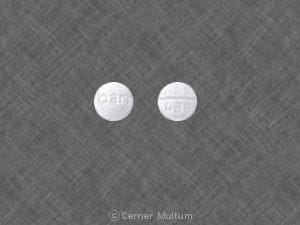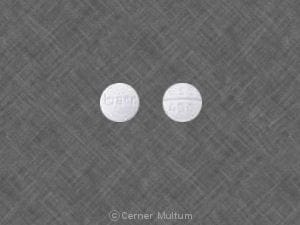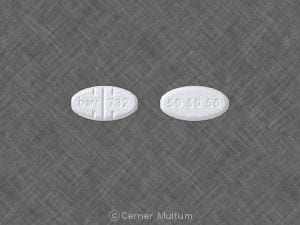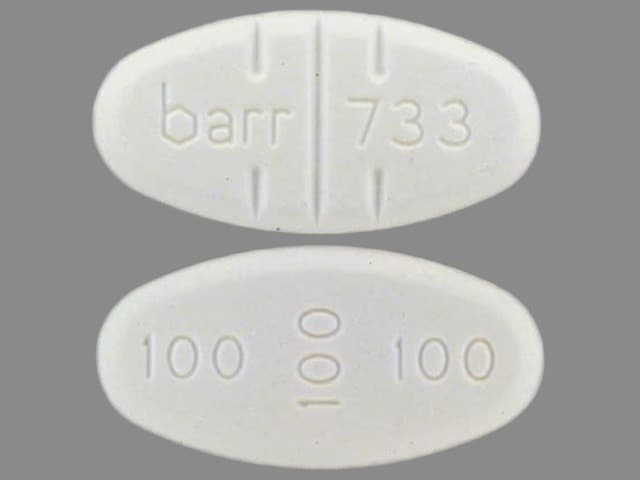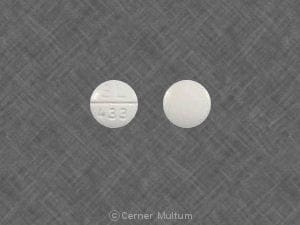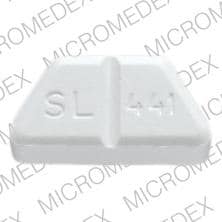Boxed Warning
Suicidal thoughts and behaviors:
Antidepressants increase the risk of suicidal thoughts and behaviors in pediatric and young adult patients in short-term studies. Closely monitor all antidepressant-treated patients for clinical worsening, and for emergence of suicidal thoughts and behaviors. Trazodone is not approved for use in pediatric patients.
Dosage Forms
Excipient information presented when available (limited, particularly for generics); consult specific product labeling.
Tablet, Oral, as hydrochloride:
Generic: 50 mg, 100 mg, 150 mg, 300 mg
Pharmacology
Mechanism of Action
Inhibits reuptake of serotonin, causes adrenoreceptor subsensitivity, acts as a 5HT2a receptor antagonist and induces significant changes in 5-HT presynaptic receptor adrenoreceptors. Trazodone also significantly blocks histamine (H1) and alpha1-adrenergic receptors.
Pharmacokinetics/Pharmacodynamics
Absorption
Well absorbed. Food increases absorption, decreases peak concentration and delays time to peak concentration of immediate release tablet; Extended release: Cmax increases ~86% when taken shortly after ingestion of a high-fat meal compared to fasting conditions
Metabolism
Hepatic via CYP3A4 (extensive) to an active metabolite (mCPP)
Excretion
Primarily urine (74%, <1% excreted unchanged); secondarily feces (~21%)
Onset of Action
Therapeutic (antidepressant): Up to 6 weeks (APA 2010)
Time to Peak
Immediate release: 30 to 100 minutes; delayed with food (up to 2.5 hours)
Extended release: 9 hours; not significantly affected by food
Half-Life Elimination
5 to 9 hours, prolonged in obese patients
Protein Binding
89% to 95%
Use: Labeled Indications
Major depressive disorder (unipolar): Treatment of unipolar major depressive disorder
Use: Off Label
Aggressive or agitated behavior associated with dementiacyes
Data from a limited number of patients studied suggest that trazodone may be beneficial in decreasing symptom frequency and severity, as well as decreasing use of adjunctive medications, in patients with aggression or agitation associated with dementia Lebert 2004, Sultzer 1997.
Based on the
Insomniac
Data from a meta-analysis of a limited number of controlled trials in patients with and without comorbid conditions (including Alzheimer disease, depression, and opioid dependence) suggest that trazodone may be beneficial in the short-term to decrease number of awakenings and improve sleep quality in patients with insomnia Yi 2018.
The
Contraindications
Hypersensitivity to trazodone or any component of the formulation; use of MAOIs intended to treat psychiatric disorders (concurrently or within 14 days of discontinuing either trazodone or the MAOI); initiation of trazodone in a patient receiving linezolid or intravenous methylene blue
Dosage and Administration
Dosing: Adult
Note: Oleptro, the extended-release formulation, has been discontinued in the United States for more than 1 year.
Aggressive or agitated behavior associated with dementia (alternative agent) (off-label use): Based on limited data: Oral: Immediate release: Initial: 25 to 50 mg once daily at bedtime; may increase dose gradually based on response and tolerability up to 300 mg/day in 1 to 3 divided doses (APA [Rabins 2007]; Lebert 2004; Sultzer 1997). Some experts target doses in the lower end of the dosing range, rarely using doses as high as 100 to 150 mg/day (Press 2019; WFSBP [Ihl 2011]).
Insomnia (alternative agent) (off-label use): Oral: Immediate release: Usual dose: 50 mg to 100 mg at bedtime (Yi 2018). Note: Lower initial doses of 12.5 to 50 mg at bedtime may be considered (eg, in palliative care patients) (McCleery 2014; Tanimukai 2013). May consider increasing dose based on response and tolerability up to 200 mg at bedtime (eg, in patients with substance use disorder) (Friedmann 2008; Le Bon 2003). In patients with substance use disorder, trazodone may be preferred due to its low abuse potential (APA 2006).
Insomnia in patients with depression (as adjunct to other appropriate antidepressant treatment [eg SSRI]): Oral: Immediate release: Usual dose: 50 to 300 mg at bedtime. Doses up to 600 mg/day have been evaluated; however, evidence of greater benefit is uncertain and adverse effects may be increased (Mendelson 2005).
Major depressive disorder (unipolar) (alternative agent): Oral:
Immediate release: Initial: 50 mg twice daily; may increase in increments of 50 mg/day every 3 to 7 days to a target dose of 75 to 150 mg twice daily. Thereafter may further increase by 50 to 100 mg/day every 2 to 4 weeks based on response and tolerability; usual dosage range 200 to 400 mg/day; maximum 600 mg/day. Note: Adverse effects are increased with doses >400 mg/day and are not recommended in patients with cardiovascular disease; sedative effects may be better tolerated by dividing the daily dose to give a smaller dose in daytime and larger dose before bedtime (Hirsch 2018c).
Manufacturer’s labeling: Dosing in prescribing information may not reflect current clinical practice. Initial: 150 mg/day in divided doses; maximum dose: 600 mg/day (inpatients); 400 mg/day (outpatients).
Extended release: Initial: 150 mg once daily at bedtime; may increase by 75 mg/day at intervals no less than every 3 days based on response, tolerability, and severity of symptoms; maximum dose: 375 mg/day
Discontinuation of therapy: When discontinuing antidepressants, gradually taper the dose (eg, over 2 to 4 weeks) to minimize the incidence of withdrawal symptoms and allow for the detection of re-emerging symptoms (APA 2010; WFSBP [Bauer 2015]); antidepressants with a shorter half-life may need to be tapered more slowly (APA 2010) (eg, over 4 weeks [Hirsch 2018a]). If intolerable withdrawal symptoms occur following a dose reduction, resume the previously prescribed dose and/or decrease dose at a more gradual rate (Shelton 2001). Select patients (eg, those with a history of discontinuation syndrome) on long-term treatment (>6 months) may benefit from tapering over >3 months (WFSBP [Bauer 2015]). Evidence supporting ideal taper rates is limited (Shelton 2001; WFSBP [Bauer 2015]).
Switching antidepressants: Evidence for ideal antidepressant switching strategies is limited; strategies include cross-titration (gradually discontinuing the first antidepressant while at the same time gradually increasing the new antidepressant) and direct switch (abruptly discontinuing the first antidepressant and then starting the new antidepressant at an equivalent dose or lower dose and increasing it gradually). Cross-titration (eg, over 1 to 4 weeks depending upon sensitivity to discontinuation symptoms and adverse effects) is standard for most switches, but is contraindicated when switching to or from an MAOI. A direct switch may be an appropriate approach when switching to another agent in the same or similar class (eg, when switching between two SSRIs), when the antidepressant to be discontinued has been used for <1 week, or when the discontinuation is for adverse effects. When choosing the switch strategy, consider the risk of discontinuation symptoms, potential for drug interactions, other antidepressant properties (eg, half-life, adverse effects, and pharmacodynamics), and the degree of symptom control desired (Hirsch 2018b; Ogle 2013; WFSBP [Bauer 2013]).
Switching to or from an MAOI:
Allow 14 days to elapse between discontinuing an MAOI and initiation of trazodone.
Allow 14 days to elapse between discontinuing trazodone and initiation of an MAOI.
Dosing: Geriatric
Major depressive disorder (unipolar) (alternative agent):
Immediate release: Oral: Initial: 25 to 50 mg at bedtime; may increase in increments of 25 to 50 mg/day every 3 days for inpatients and weekly for outpatients, if tolerated; usual dose: 75 to 150 mg/day
Extended release: Refer to adult dosing. Use with caution in the elderly; clinical experience is limited.
Discontinuation of therapy: Refer to adult dosing.
Switching antidepressants: Refer to adult dosing.
Dosing: Pediatric
Insomnia; sleep disturbances (in children with comorbid psychiatric disorders): Limited data available; frequently used clinically in children with comorbid psychiatric disorders (eg, mood disorder, anxiety disorder, developmental delay with ADHD) (Owens 2010): Oral: Immediate release formulation:
Children 18 months to 5 years: Dosing based on a subset of a pediatric trial which included young children (n=16; range: 20 months to 5 years) with opsoclonus-myoclonus syndrome and used fixed doses (see below); however, the median overall dose (n=19) reported was 2.6 mg/kg/day (range: 1.2 to 6.9 mg/kg/day) (Pranzatelli 2005)
Children 18 months to <3 years: Initial: 25 mg/dose at bedtime; may increase dose at 2-week intervals in 25 mg increments; maximum dose: 100 mg/dose
Children 3 to 5 years: Initial 50 mg/dose at bedtime; may increase dose at 2-week intervals in 25 mg increments; maximum dose: 150 mg/dose
Children >5 years and Adolescents: Initial: 0.75 to 1 mg/kg/dose or 25 to 50 mg at bedtime; reported range: 0.5 to 2 mg/kg/day (do not to exceed adult dosing: 200 mg/day); reported trials conducted in pediatric patients with comorbid psychiatric disorders (eg, ADHD, autism, developmental delay), or sleep bruxism (Hollway 2011; Kratochvil 2005); when used for palliative care, multiple daily dosing may be necessary; 25 to 50 mg/dose increase gradually to twice or three times daily as needed (do not exceed adult dosing)
Migraine, prophylaxis: Limited data available: Efficacy results variable: Children and Adolescents ≥7 years: Oral: Immediate release formulation: 1 mg/kg/day in 3 divided doses; maximum dose: 150 mg/dose (Battistella 1993; Damen 2005; Lewis 2004)
Discontinuation of therapy: Upon discontinuation of antidepressant therapy, gradually taper the dose to minimize the incidence of withdrawal symptoms and allow for the detection of reemerging symptoms. Evidence supporting ideal taper rates is limited. APA and NICE guidelines suggest tapering therapy over at least several weeks with consideration to the half-life of the antidepressant; antidepressants with a shorter half-life may need to be tapered more conservatively. In addition for long-term treated patients, WFSBP guidelines recommend tapering over 4 to 6 months. If intolerable withdrawal symptoms occur following a dose reduction, consider resuming the previously prescribed dose and/or decrease dose at a more gradual rate (APA 2010; Bauer 2002; Haddad 2001; NCCMH 2010; Schatzberg 2006; Shelton 2001; Warner 2006).
MAO inhibitor recommendations:
Switching to or from an MAO inhibitor intended to treat psychiatric disorders:
Allow 14 days to elapse between discontinuing an MAO inhibitor intended to treat psychiatric disorders and initiation of trazodone.
Allow 14 days to elapse between discontinuing trazodone and initiation of an MAO inhibitor intended to treat psychiatric disorders.
Use with other MAO inhibitors (linezolid or IV methylene blue):
Do not initiate trazodone in patients receiving linezolid or IV methylene blue; consider other interventions for psychiatric condition.
If urgent treatment with linezolid or IV methylene blue is required in a patient already receiving trazodone and potential benefits outweigh potential risks, discontinue trazodone promptly and administer linezolid or IV methylene blue. Monitor for serotonin syndrome for 2 weeks or until 24 hours after the last dose of linezolid or IV methylene blue, whichever comes first. May resume trazodone 24 hours after the last dose of linezolid or IV methylene blue.
Administration
Oral:
Immediate-release tablet: Administer shortly after a meal or light snack; swallow whole or as a half tablet by breaking along the score line.
Extended-release tablet: Take on an empty stomach; swallow whole or as a half tablet without food. Tablet may be broken along the score line, but do not crush or chew.
Storage
Immediate-release tablet: Store at 20ºC to 25ºC (68ºF to 77ºF); excursions permitted between 15ºC to 30ºC (59ºF to 86ºF). Protect from light.
Extended-release tablet: Store at room temperature of 15ºC to 30ºC (59ºF to 86ºF). Protect from light.
TraZODone Images
Drug Interactions
Alcohol (Ethyl): May enhance the adverse/toxic effect of TraZODone. Specifically, effects on sleepiness, dizziness, and manual dexterity may be enhanced. Monitor therapy
Alizapride: May enhance the CNS depressant effect of CNS Depressants. Monitor therapy
Almotriptan: May enhance the serotonergic effect of Serotonergic Agents (High Risk). This could result in serotonin syndrome. Management: Monitor for signs and symptoms of serotonin syndrome/serotonin toxicity (eg, hyperreflexia, clonus, hyperthermia, diaphoresis, tremor, autonomic instability, mental status changes) when these agents are combined. Monitor therapy
Alosetron: May enhance the serotonergic effect of Serotonergic Agents (High Risk). This could result in serotonin syndrome. Management: Monitor for signs and symptoms of serotonin syndrome/serotonin toxicity (eg, hyperreflexia, clonus, hyperthermia, diaphoresis, tremor, autonomic instability, mental status changes) when these agents are combined. Monitor therapy
Amphetamines: May enhance the serotonergic effect of Serotonergic Agents (High Risk). This could result in serotonin syndrome. Management: Monitor for signs and symptoms of serotonin syndrome/serotonin toxicity (eg, hyperreflexia, clonus, hyperthermia, diaphoresis, tremor, autonomic instability, mental status changes) when these agents are combined. Monitor therapy
Antiemetics (5HT3 Antagonists): May enhance the serotonergic effect of Serotonergic Agents (High Risk). This could result in serotonin syndrome. Management: Monitor for signs and symptoms of serotonin syndrome/serotonin toxicity (eg, hyperreflexia, clonus, hyperthermia, diaphoresis, tremor, autonomic instability, mental status changes) when these agents are combined. Exceptions: Alosetron; Ondansetron; Ramosetron. Monitor therapy
Antipsychotic Agents: Serotonergic Agents (High Risk) may enhance the adverse/toxic effect of Antipsychotic Agents. Specifically, serotonergic agents may enhance dopamine blockade, possibly increasing the risk for neuroleptic malignant syndrome. Antipsychotic Agents may enhance the serotonergic effect of Serotonergic Agents (High Risk). This could result in serotonin syndrome. Monitor therapy
Antipsychotic Agents (Phenothiazines): May enhance the adverse/toxic effect of Serotonin Reuptake Inhibitor/Antagonists. Specifically, this may be manifest as symptoms consistent with serotonin syndrome or neuroleptic malignant syndrome. Serotonin Reuptake Inhibitor/Antagonists may enhance the hypotensive effect of Antipsychotic Agents (Phenothiazines). Monitor therapy
Aprepitant: May increase the serum concentration of CYP3A4 Substrates (High risk with Inhibitors). Monitor therapy
Azelastine (Nasal): CNS Depressants may enhance the CNS depressant effect of Azelastine (Nasal). Avoid combination
Blonanserin: CNS Depressants may enhance the CNS depressant effect of Blonanserin. Consider therapy modification
Bosentan: May decrease the serum concentration of CYP3A4 Substrates (High risk with Inducers). Monitor therapy
Brexanolone: CNS Depressants may enhance the CNS depressant effect of Brexanolone. Monitor therapy
Brexanolone: Serotonin Reuptake Inhibitor/Antagonists may enhance the CNS depressant effect of Brexanolone. Monitor therapy
Brimonidine (Topical): May enhance the CNS depressant effect of CNS Depressants. Monitor therapy
Bromopride: May enhance the CNS depressant effect of CNS Depressants. Monitor therapy
Bromperidol: May enhance the CNS depressant effect of CNS Depressants. Avoid combination
Buprenorphine: CNS Depressants may enhance the CNS depressant effect of Buprenorphine. Management: Consider reduced doses of other CNS depressants, and avoiding such drugs in patients at high risk of buprenorphine overuse/self-injection. Initiate buprenorphine at lower doses in patients already receiving CNS depressants. Consider therapy modification
BusPIRone: May enhance the serotonergic effect of Serotonergic Agents (High Risk). This could result in serotonin syndrome. Management: Monitor for signs and symptoms of serotonin syndrome/serotonin toxicity (eg, hyperreflexia, clonus, hyperthermia, diaphoresis, tremor, autonomic instability, mental status changes) when these agents are combined. Monitor therapy
Cannabidiol: May enhance the CNS depressant effect of CNS Depressants. Monitor therapy
Cannabis: May enhance the CNS depressant effect of CNS Depressants. Monitor therapy
Chlormethiazole: May enhance the CNS depressant effect of CNS Depressants. Management: Monitor closely for evidence of excessive CNS depression. The chlormethiazole labeling states that an appropriately reduced dose should be used if such a combination must be used. Consider therapy modification
Chlorphenesin Carbamate: May enhance the adverse/toxic effect of CNS Depressants. Monitor therapy
Clofazimine: May increase the serum concentration of CYP3A4 Substrates (High risk with Inhibitors). Monitor therapy
CNS Depressants: May enhance the adverse/toxic effect of other CNS Depressants. Monitor therapy
Conivaptan: May increase the serum concentration of CYP3A4 Substrates (High risk with Inhibitors). Avoid combination
Cyclobenzaprine: May enhance the serotonergic effect of Serotonergic Agents (High Risk). This could result in serotonin syndrome. Management: Monitor for signs and symptoms of serotonin syndrome/serotonin toxicity (eg, hyperreflexia, clonus, hyperthermia, diaphoresis, tremor, autonomic instability, mental status changes) when these agents are combined. Monitor therapy
CYP3A4 Inducers (Moderate): May decrease the serum concentration of CYP3A4 Substrates (High risk with Inducers). Monitor therapy
CYP3A4 Inducers (Strong): May increase the metabolism of CYP3A4 Substrates (High risk with Inducers). Management: Consider an alternative for one of the interacting drugs. Some combinations may be specifically contraindicated. Consult appropriate manufacturer labeling. Consider therapy modification
CYP3A4 Inhibitors (Moderate): May decrease the metabolism of CYP3A4 Substrates (High risk with Inhibitors). Monitor therapy
CYP3A4 Inhibitors (Strong): May increase the serum concentration of TraZODone. Management: Consider the use of a lower trazodone dose and monitor for increased trazodone effects (eg, sedation, QTc prolongation) if combined with strong CYP3A4 inhibitors. Exceptions: Nefazodone. Consider therapy modification
Dabrafenib: May decrease the serum concentration of CYP3A4 Substrates (High risk with Inducers). Management: Seek alternatives to the CYP3A4 substrate when possible. If concomitant therapy cannot be avoided, monitor clinical effects of the substrate closely (particularly therapeutic effects). Consider therapy modification
Dapoxetine: May enhance the serotonergic effect of Serotonergic Agents (High Risk). This could result in serotonin syndrome. Management: Do not use serotonergic agents (high risk) with dapoxetine or within 7 days of serotonergic agent discontinuation. Do not use dapoxetine within 14 days of monoamine oxidase inhibitor use. Dapoxetine labeling lists this combination as contraindicated. Avoid combination
Deferasirox: May decrease the serum concentration of CYP3A4 Substrates (High risk with Inducers). Monitor therapy
Dexmethylphenidate-Methylphenidate: May enhance the serotonergic effect of Serotonergic Agents (High Risk). This could result in serotonin syndrome. Management: Monitor for signs and symptoms of serotonin syndrome/serotonin toxicity (eg, hyperreflexia, clonus, hyperthermia, diaphoresis, tremor, autonomic instability, mental status changes) when these agents are combined. Monitor therapy
Dextromethorphan: May enhance the serotonergic effect of Serotonergic Agents (High Risk). This could result in serotonin syndrome. Management: Monitor for signs and symptoms of serotonin syndrome/serotonin toxicity (eg, hyperreflexia, clonus, hyperthermia, diaphoresis, tremor, autonomic instability, mental status changes) when these agents are combined. Monitor therapy
Dimethindene (Topical): May enhance the CNS depressant effect of CNS Depressants. Monitor therapy
Doxylamine: May enhance the CNS depressant effect of CNS Depressants. Management: The manufacturer of Diclegis (doxylamine/pyridoxine), intended for use in pregnancy, specifically states that use with other CNS depressants is not recommended. Monitor therapy
Dronabinol: May enhance the CNS depressant effect of CNS Depressants. Monitor therapy
Droperidol: May enhance the CNS depressant effect of CNS Depressants. Management: Consider dose reductions of droperidol or of other CNS agents (eg, opioids, barbiturates) with concomitant use. Exceptions to this monograph are discussed in further detail in separate drug interaction monographs. Consider therapy modification
Duvelisib: May increase the serum concentration of CYP3A4 Substrates (High risk with Inhibitors). Monitor therapy
Eletriptan: May enhance the serotonergic effect of Serotonergic Agents (High Risk). This could result in serotonin syndrome. Management: Monitor for signs and symptoms of serotonin syndrome/serotonin toxicity (eg, hyperreflexia, clonus, hyperthermia, diaphoresis, tremor, autonomic instability, mental status changes) when these agents are combined. Monitor therapy
Enzalutamide: May decrease the serum concentration of CYP3A4 Substrates (High risk with Inducers). Management: Concurrent use of enzalutamide with CYP3A4 substrates that have a narrow therapeutic index should be avoided. Use of enzalutamide and any other CYP3A4 substrate should be performed with caution and close monitoring. Consider therapy modification
Erdafitinib: May decrease the serum concentration of CYP3A4 Substrates (High risk with Inducers). Monitor therapy
Erdafitinib: May increase the serum concentration of CYP3A4 Substrates (High risk with Inhibitors). Monitor therapy
Ergot Derivatives: May enhance the serotonergic effect of Serotonergic Agents (High Risk). This could result in serotonin syndrome. Management: Monitor for signs and symptoms of serotonin syndrome/serotonin toxicity (eg, hyperreflexia, clonus, hyperthermia, diaphoresis, tremor, autonomic instability, mental status changes) when these agents are combined. Exceptions: Nicergoline. Monitor therapy
Esketamine: May enhance the CNS depressant effect of CNS Depressants. Monitor therapy
Flunitrazepam: CNS Depressants may enhance the CNS depressant effect of Flunitrazepam. Consider therapy modification
Fosaprepitant: May increase the serum concentration of CYP3A4 Substrates (High risk with Inhibitors). Monitor therapy
Fosnetupitant: May increase the serum concentration of CYP3A4 Substrates (High risk with Inhibitors). Monitor therapy
Fosphenytoin: May decrease the serum concentration of TraZODone. TraZODone may increase the serum concentration of Fosphenytoin. Monitor therapy
Fusidic Acid (Systemic): May increase the serum concentration of CYP3A4 Substrates (High risk with Inhibitors). Avoid combination
Haloperidol: QT-prolonging Agents (Indeterminate Risk - Caution) may enhance the QTc-prolonging effect of Haloperidol. Monitor therapy
HYDROcodone: CNS Depressants may enhance the CNS depressant effect of HYDROcodone. Management: Avoid concomitant use of hydrocodone and benzodiazepines or other CNS depressants when possible. These agents should only be combined if alternative treatment options are inadequate. If combined, limit the dosages and duration of each drug. Consider therapy modification
HydrOXYzine: May enhance the CNS depressant effect of CNS Depressants. Monitor therapy
Idelalisib: May increase the serum concentration of CYP3A4 Substrates (High risk with Inhibitors). Avoid combination
Ivosidenib: May decrease the serum concentration of CYP3A4 Substrates (High risk with Inducers). Monitor therapy
Kava Kava: May enhance the adverse/toxic effect of CNS Depressants. Monitor therapy
Larotrectinib: May increase the serum concentration of CYP3A4 Substrates (High risk with Inhibitors). Monitor therapy
Lasmiditan: May enhance the serotonergic effect of Serotonergic Agents (High Risk). This could result in serotonin syndrome. Management: Monitor for signs and symptoms of serotonin syndrome/serotonin toxicity (eg, hyperreflexia, clonus, hyperthermia, diaphoresis, tremor, autonomic instability, mental status changes) when these agents are combined. Monitor therapy
Lemborexant: May enhance the CNS depressant effect of CNS Depressants. Management: Dosage adjustments of lemborexant and of concomitant CNS depressants may be necessary when administered together because of potentially additive CNS depressant effects. Close monitoring for CNS depressant effects is necessary. Consider therapy modification
Linezolid: May enhance the serotonergic effect of Serotonergic Non-Opioid CNS Depressants. This could result in serotonin syndrome. Avoid combination
Lofexidine: May enhance the CNS depressant effect of CNS Depressants. Management: Drugs listed as exceptions to this monograph are discussed in further detail in separate drug interaction monographs. Monitor therapy
Lorcaserin: May enhance the serotonergic effect of Serotonergic Agents (High Risk). This could result in serotonin syndrome. Management: Monitor for signs and symptoms of serotonin syndrome/serotonin toxicity (eg, hyperreflexia, clonus, hyperthermia, diaphoresis, tremor, autonomic instability, mental status changes) when these agents are combined. Monitor therapy
Lorlatinib: May decrease the serum concentration of CYP3A4 Substrates (High risk with Inducers). Management: Avoid concurrent use of lorlatinib with any CYP3A4 substrates for which a minimal decrease in serum concentrations of the CYP3A4 substrate could lead to therapeutic failure and serious clinical consequences. Consider therapy modification
Magnesium Sulfate: May enhance the CNS depressant effect of CNS Depressants. Monitor therapy
Metaxalone: May enhance the serotonergic effect of Serotonergic Agents (High Risk). This could result in serotonin syndrome. Management: Monitor for signs and symptoms of serotonin syndrome/serotonin toxicity (eg, hyperreflexia, clonus, hyperthermia, diaphoresis, tremor, autonomic instability, mental status changes) when these agents are combined. Monitor therapy
Methotrimeprazine: CNS Depressants may enhance the CNS depressant effect of Methotrimeprazine. Methotrimeprazine may enhance the CNS depressant effect of CNS Depressants. Management: Reduce adult dose of CNS depressant agents by 50% with initiation of concomitant methotrimeprazine therapy. Further CNS depressant dosage adjustments should be initiated only after clinically effective methotrimeprazine dose is established. Consider therapy modification
Methylene Blue: Serotonergic Non-Opioid CNS Depressants may enhance the serotonergic effect of Methylene Blue. This could result in serotonin syndrome. Avoid combination
MetyroSINE: CNS Depressants may enhance the sedative effect of MetyroSINE. Monitor therapy
MiFEPRIStone: May increase the serum concentration of CYP3A4 Substrates (High risk with Inhibitors). Management: Minimize doses of CYP3A4 substrates, and monitor for increased concentrations/toxicity, during and 2 weeks following treatment with mifepristone. Avoid cyclosporine, dihydroergotamine, ergotamine, fentanyl, pimozide, quinidine, sirolimus, and tacrolimus. Consider therapy modification
Minocycline (Systemic): May enhance the CNS depressant effect of CNS Depressants. Monitor therapy
Mirtazapine: TraZODone may enhance the CNS depressant effect of Mirtazapine. TraZODone may enhance the serotonergic effect of Mirtazapine. This could result in serotonin syndrome. Management: Monitor for signs and symptoms of serotonin syndrome/serotonin toxicity (eg, hyperreflexia, clonus, hyperthermia, diaphoresis, tremor, autonomic instability, mental status changes) and CNS depression when these agents are combined. Monitor therapy
Mitotane: May decrease the serum concentration of CYP3A4 Substrates (High risk with Inducers). Management: Doses of CYP3A4 substrates may need to be adjusted substantially when used in patients being treated with mitotane. Consider therapy modification
Monoamine Oxidase Inhibitors (Antidepressant): Serotonergic Non-Opioid CNS Depressants may enhance the serotonergic effect of Monoamine Oxidase Inhibitors (Antidepressant). This could result in serotonin syndrome. Avoid combination
Nabilone: May enhance the CNS depressant effect of CNS Depressants. Monitor therapy
Nefazodone: TraZODone may enhance the serotonergic effect of Nefazodone. This could result in serotonin syndrome. Nefazodone may increase the serum concentration of TraZODone. Management: Consider the use of a lower trazodone dose and monitor for increased trazodone effects such as sedation, QTc prolongation, and signs and symptoms of serotonin syndrome/serotonin toxicity when these agents are combined. Consider therapy modification
Netupitant: May increase the serum concentration of CYP3A4 Substrates (High risk with Inhibitors). Monitor therapy
Ondansetron: May enhance the serotonergic effect of Serotonergic Agents (High Risk). This could result in serotonin syndrome. Management: Monitor for signs and symptoms of serotonin syndrome/serotonin toxicity (eg, hyperreflexia, clonus, hyperthermia, diaphoresis, tremor, autonomic instability, mental status changes) when these agents are combined. Monitor therapy
Opioid Agonists: CNS Depressants may enhance the CNS depressant effect of Opioid Agonists. Management: Avoid concomitant use of opioid agonists and benzodiazepines or other CNS depressants when possible. These agents should only be combined if alternative treatment options are inadequate. If combined, limit the dosages and duration of each drug. Consider therapy modification
Orphenadrine: CNS Depressants may enhance the CNS depressant effect of Orphenadrine. Avoid combination
Oxitriptan: Serotonergic Agents (High Risk) may enhance the serotonergic effect of Oxitriptan. This could result in serotonin syndrome. Management: Monitor for signs and symptoms of serotonin syndrome/serotonin toxicity (eg, hyperreflexia, clonus, hyperthermia, diaphoresis, tremor, autonomic instability, mental status changes) when these agents are combined. Monitor therapy
Oxomemazine: May enhance the CNS depressant effect of CNS Depressants. Avoid combination
OxyCODONE: CNS Depressants may enhance the CNS depressant effect of OxyCODONE. Management: Avoid concomitant use of oxycodone and benzodiazepines or other CNS depressants when possible. These agents should only be combined if alternative treatment options are inadequate. If combined, limit the dosages and duration of each drug. Consider therapy modification
Palbociclib: May increase the serum concentration of CYP3A4 Substrates (High risk with Inhibitors). Monitor therapy
Paraldehyde: CNS Depressants may enhance the CNS depressant effect of Paraldehyde. Avoid combination
Perampanel: May enhance the CNS depressant effect of CNS Depressants. Management: Patients taking perampanel with any other drug that has CNS depressant activities should avoid complex and high-risk activities, particularly those such as driving that require alertness and coordination, until they have experience using the combination. Consider therapy modification
Phenytoin: May decrease the serum concentration of TraZODone. TraZODone may increase the serum concentration of Phenytoin. Monitor therapy
Piribedil: CNS Depressants may enhance the CNS depressant effect of Piribedil. Monitor therapy
Pramipexole: CNS Depressants may enhance the sedative effect of Pramipexole. Monitor therapy
QT-prolonging Agents (Highest Risk): QT-prolonging Agents (Indeterminate Risk - Caution) may enhance the QTc-prolonging effect of QT-prolonging Agents (Highest Risk). Management: Monitor for QTc interval prolongation and ventricular arrhythmias when these agents are combined. Patients with additional risk factors for QTc prolongation may be at even higher risk. Monitor therapy
Ramosetron: May enhance the serotonergic effect of Serotonergic Agents (High Risk). This could result in serotonin syndrome. Management: Monitor for signs and symptoms of serotonin syndrome/serotonin toxicity (eg, hyperreflexia, clonus, hyperthermia, diaphoresis, tremor, autonomic instability, mental status changes) when these agents are combined. Monitor therapy
Rasagiline: May enhance the serotonergic effect of Serotonergic Non-Opioid CNS Depressants. This could result in serotonin syndrome. Avoid combination
ROPINIRole: CNS Depressants may enhance the sedative effect of ROPINIRole. Monitor therapy
Rotigotine: CNS Depressants may enhance the sedative effect of Rotigotine. Monitor therapy
Rufinamide: May enhance the adverse/toxic effect of CNS Depressants. Specifically, sleepiness and dizziness may be enhanced. Monitor therapy
Safinamide: May enhance the serotonergic effect of Serotonergic Non-Opioid CNS Depressants. This could result in serotonin syndrome. Avoid combination
Saquinavir: May enhance the QTc-prolonging effect of TraZODone. Saquinavir may increase the serum concentration of TraZODone. Avoid combination
Sarilumab: May decrease the serum concentration of CYP3A4 Substrates (High risk with Inducers). Monitor therapy
Selective Serotonin Reuptake Inhibitors: CNS Depressants may enhance the adverse/toxic effect of Selective Serotonin Reuptake Inhibitors. Specifically, the risk of psychomotor impairment may be enhanced. Monitor therapy
Selective Serotonin Reuptake Inhibitors: May enhance the serotonergic effect of Serotonergic Non-Opioid CNS Depressants. This could result in serotonin syndrome. Management: Monitor for signs and symptoms of serotonin syndrome/serotonin toxicity (eg, hyperreflexia, clonus, hyperthermia, diaphoresis, tremor, autonomic instability, mental status changes) when these agents are combined. Exceptions: Dapoxetine. Monitor therapy
Selegiline: May enhance the serotonergic effect of Serotonergic Non-Opioid CNS Depressants. This could result in serotonin syndrome. Avoid combination
Serotonergic Agents (High Risk, Miscellaneous): May enhance the serotonergic effect of Serotonergic Non-Opioid CNS Depressants. This could result in serotonin syndrome. Management: Monitor for signs and symptoms of serotonin syndrome/serotonin toxicity (eg, hyperreflexia, clonus, hyperthermia, diaphoresis, tremor, autonomic instability, mental status changes) when these agents are combined. Monitor therapy
Serotonergic Opioids (High Risk): Serotonergic Non-Opioid CNS Depressants may enhance the CNS depressant effect of Serotonergic Opioids (High Risk). Serotonergic Non-Opioid CNS Depressants may enhance the serotonergic effect of Serotonergic Opioids (High Risk). This could result in serotonin syndrome. Management: Consider alternatives to this drug combination. If combined, monitor for signs and symptoms of serotonin syndrome/serotonin toxicity and CNS depression. Consider therapy modification
Serotonin 5-HT1D Receptor Agonists (Triptans): May enhance the serotonergic effect of Serotonergic Agents (High Risk). This could result in serotonin syndrome. Management: Monitor for signs and symptoms of serotonin syndrome/serotonin toxicity (eg, hyperreflexia, clonus, hyperthermia, diaphoresis, tremor, autonomic instability, mental status changes) when these agents are combined. Exceptions: Almotriptan; Eletriptan. Monitor therapy
Serotonin/Norepinephrine Reuptake Inhibitors: TraZODone may enhance the serotonergic effect of Serotonin/Norepinephrine Reuptake Inhibitors. This could result in serotonin syndrome. Management: Monitor for signs and symptoms of serotonin syndrome/serotonin toxicity (eg, hyperreflexia, clonus, hyperthermia, diaphoresis, tremor, autonomic instability, mental status changes) when these agents are combined. Monitor therapy
Siltuximab: May decrease the serum concentration of CYP3A4 Substrates (High risk with Inducers). Monitor therapy
Simeprevir: May increase the serum concentration of CYP3A4 Substrates (High risk with Inhibitors). Monitor therapy
Sodium Oxybate: May enhance the CNS depressant effect of CNS Depressants. Management: Consider alternatives to combined use. When combined use is needed, consider minimizing doses of one or more drugs. Use of sodium oxybate with alcohol or sedative hypnotics is contraindicated. Consider therapy modification
St John's Wort: May enhance the serotonergic effect of Serotonergic Agents (High Risk). This could result in serotonin syndrome. St John's Wort may decrease the serum concentration of Serotonergic Agents (High Risk). Management: Monitor for signs and symptoms of serotonin syndrome/serotonin toxicity (eg, hyperreflexia, clonus, hyperthermia, diaphoresis, tremor, autonomic instability, mental status changes) when these agents are combined. Monitor therapy
Stiripentol: May increase the serum concentration of CYP3A4 Substrates (High risk with Inhibitors). Management: Use of stiripentol with CYP3A4 substrates that are considered to have a narrow therapeutic index should be avoided due to the increased risk for adverse effects and toxicity. Any CYP3A4 substrate used with stiripentol requires closer monitoring. Consider therapy modification
Suvorexant: CNS Depressants may enhance the CNS depressant effect of Suvorexant. Management: Dose reduction of suvorexant and/or any other CNS depressant may be necessary. Use of suvorexant with alcohol is not recommended, and the use of suvorexant with any other drug to treat insomnia is not recommended. Consider therapy modification
Syrian Rue: May enhance the serotonergic effect of Serotonergic Agents (High Risk). This could result in serotonin syndrome. Management: Monitor for signs and symptoms of serotonin syndrome/serotonin toxicity (eg, hyperreflexia, clonus, hyperthermia, diaphoresis, tremor, autonomic instability, mental status changes) when these agents are combined. Monitor therapy
Tapentadol: May enhance the CNS depressant effect of CNS Depressants. Management: Avoid concomitant use of tapentadol and benzodiazepines or other CNS depressants when possible. These agents should only be combined if alternative treatment options are inadequate. If combined, limit the dosages and duration of each drug. Consider therapy modification
Tetrahydrocannabinol: May enhance the CNS depressant effect of CNS Depressants. Monitor therapy
Tetrahydrocannabinol and Cannabidiol: May enhance the CNS depressant effect of CNS Depressants. Monitor therapy
Thalidomide: CNS Depressants may enhance the CNS depressant effect of Thalidomide. Avoid combination
Tocilizumab: May decrease the serum concentration of CYP3A4 Substrates (High risk with Inducers). Monitor therapy
Tricyclic Antidepressants: May enhance the CNS depressant effect of Serotonergic Non-Opioid CNS Depressants. Tricyclic Antidepressants may enhance the serotonergic effect of Serotonergic Non-Opioid CNS Depressants. This could result in serotonin syndrome. Management: Monitor for signs and symptoms of serotonin syndrome/serotonin toxicity (eg, hyperreflexia, clonus, hyperthermia, diaphoresis, tremor, autonomic instability, mental status changes) and CNS depression when these agents are combined. Monitor therapy
Trimeprazine: May enhance the CNS depressant effect of CNS Depressants. Monitor therapy
Warfarin: TraZODone may diminish the anticoagulant effect of Warfarin. Monitor therapy
Zolpidem: CNS Depressants may enhance the CNS depressant effect of Zolpidem. Management: Reduce the Intermezzo brand sublingual zolpidem adult dose to 1.75 mg for men who are also receiving other CNS depressants. No such dose change is recommended for women. Avoid use with other CNS depressants at bedtime; avoid use with alcohol. Consider therapy modification
Test Interactions
May interfere with urine detection of amphetamine/methamphetamine (false-positive) (Brahm 2010).
Adverse Reactions
>10%:
Central nervous system: Drowsiness (24% to 41%), dizziness (20% to 28%), headache (10% to 20%), nervousness (15%), fatigue (6% to 11%)
Gastrointestinal: Xerostomia (15% to 34%), nausea and vomiting (10% to 13%)
Ophthalmic: Blurred vision (6% to 15%)
1% to 10%:
Cardiovascular: Hypotension (4% to 7%), syncope (3% to 5%), palpitations (<2%), sinus bradycardia (<2%), tachycardia (<2%; may include syncope)
Central nervous system: Confusion (5%), ataxia (2% to 5%), heavy headedness (3%), malaise (3%), lack of concentration (1% to 3%), disorientation (2%), akathisia (<2%), chest pain (<2%), delusions (<2%), hallucination (<2%), hypomania (<2%), memory impairment (<2%), numbness (<2%), paresthesia (<2%), speech disturbance (<2%)
Endocrine & metabolic: Weight loss (6%), weight gain (1% to 5%), change in menstrual flow (<2%), increased libido (<2%)
Gastrointestinal: Constipation (7% to 8%), gastrointestinal disease (6%), diarrhea (5%), flatulence (<2%), increased appetite (<2%), sialorrhea (<2%)
Genitourinary: Early menses (<2%), hematuria (<2%), impotence (<2%), retrograde ejaculation (<2%), urinary frequency (<2%), urinary hesitancy (<2%)
Hematologic & oncologic: Anemia (<2%)
Hypersensitivity: Angioedema (3% to 7%), hypersensitivity reaction (<2%)
Neuromuscular & skeletal: Myalgia (5% to 6%), tremor (3% to 5%), muscle twitching (<2%)
Ophthalmic: Asthenopia (≤3%), eye pruritus (≤3%), eye redness (≤3%)
Respiratory: Nasal congestion (≤6%), paranasal sinus congestion (≤6%), dyspnea (<2%)
Frequency not defined:
Cardiovascular: Hypertension, ventricular premature contractions
Central nervous system: Suicidal ideation, suicidal tendencies
<1%, postmarketing, and/or case reports: Abnormal dreams, agitation, alopecia, anxiety, aphasia, apnea, asthenia, atrial fibrillation, bradycardia, breast engorgement, breast hypertrophy, cardiac arrhythmia, cardiac conduction disturbance, cardiac failure, cerebrovascular accident, chills, cholestasis, diplopia, edema, esophageal achalasia, extrapyramidal reaction, female sexual disorder (clitorism), hemolytic anemia, hirsutism, hyperbilirubinemia, increased amylase, insomnia, jaundice, lactation, leukocytosis, leukonychia, liver enzyme disorder, methemoglobinemia, myocardial infarction, orthostatic hypotension, paranoia, priapism, prolonged QT interval on ECG, pruritus, psoriasis, psychosis, SIADH, skin rash, stupor, tardive dyskinesia, tonic clonic epilepsy, torsades de pointes, urinary incontinence, urinary retention, urticaria, vasodilation, ventricular ectopy, ventricular tachycardia, vertigo
Warnings/Precautions
Major psychiatric warnings:
- Suicidal thinking/behavior: [US Boxed Warning]: Antidepressants increase the risk of suicidal thoughts and behaviors in pediatric and young adult patients in short-term studies; consider risk prior to prescribing. Short-term studies did not show an increased risk in patients >24 years of age and showed a decreased risk in patients ≥65 years of age. Closely monitor all antidepressant-treated patients for clinical worsening, and for emergence of suicidal thoughts and behaviors, particularly during the initial 1 to 2 months of therapy or during periods of dosage adjustments (increases or decreases); the patient's family or caregiver should be instructed to closely observe the patient and communicate condition with health care provider. A medication guide concerning the use of antidepressants should be dispensed with each prescription. Trazodone is not FDA approved for use in pediatric patients.
- The possibility of a suicide attempt is inherent in major depression and may persist until remission occurs. Worsening depression and severe abrupt suicidality that are not part of the presenting symptoms may require discontinuation or modification of drug therapy. Use caution in high-risk patients during initiation of therapy.
- Prescriptions should be written for the smallest quantity consistent with good patient care. The patient's family or caregiver should be alerted to monitor patients for the emergence of suicidality and associated behaviors, such as anxiety, agitation, panic attacks, insomnia, irritability, hostility, impulsivity, akathisia, hypomania, and mania; patients should be instructed to notify their health care provider if any of these symptoms or worsening depression or psychosis occur.
Concerns related to adverse effects:
- Bleeding risk: Drugs that interfere with serotonin reuptake (eg, selective serotonin reuptake inhibitors [SSRIs]) have been associated with bleeding ranging from relatively minor bruising and epistaxis to life-threatening hemorrhage; similar to these agents, trazodone may also impair platelet aggregation resulting in increased risk of bleeding events, particularly if used concomitantly with aspirin, nonsteroidal anti-inflammatory drugs, warfarin, or other anticoagulants.
- Cardiac arrhythmias: Although the risk of conduction abnormalities is low relative to other antidepressants, QT prolongation (with or without torsades de pointes) and ventricular tachycardia have been observed with the use of trazodone (reports limited to immediate-release formulation); use with caution in patients with preexisting cardiac disease (including previous myocardial infarction [MI], stroke, tachycardia, or conduction abnormalities). Other arrhythmias reported include isolated premature ventricular contractions, ventricular couplets, and tachycardia with syncope. Concurrent use of CYP3A4 inhibitors may increase the risk of QT prolongation or other cardiac arrhythmia. Not recommended for use in a patient during the acute recovery phase of MI.
- CNS depression: May cause CNS depression, which may impair physical or mental abilities; patients must be cautioned about performing tasks that require mental alertness (eg, operating machinery, driving).
- Falls: May cause falls and major osteoporotic fractures (eg, hip, pelvis, humerus, forearm) when used in elderly patients. The fall rate was found to be similar to the rates associated with antipsychotics and benzodiazepines (Bronskill 2018; Watt 2018).
- Fractures: Bone fractures have been associated with antidepressant treatment. Consider the possibility of a fragility fracture if an antidepressant-treated patient presents with unexplained bone pain, point tenderness, swelling, or bruising (Rabenda 2013; Rizzoli 2012).
- Ocular effects: May cause mild pupillary dilation, which can lead to an episode of narrow-angle glaucoma in susceptible individuals. Consider evaluating patients who have not had an iridectomy for narrow-angle glaucoma risk factors.
- Orthostatic hypotension/syncope: May cause orthostatic hypotension and syncope (risk is high relative to other antidepressants); use with caution in patients at risk of these effects or in those who would not tolerate transient hypotensive episodes (cerebrovascular disease, cardiovascular disease, hypovolemia, or concurrent medication use that may predispose to hypotension/bradycardia).
- Priapism: Painful erection >6 hours in duration; rare. Instruct patient to seek medical assistance for erection lasting >4 hours. Use with caution in patients who have conditions which may predispose them to priapism (eg, sickle cell anemia, multiple myeloma, leukemia).
- Serotonin syndrome: Potentially life-threatening serotonin syndrome (SS) has occurred with serotonergic agents (eg, SSRIs, serotonin and norepinephrine reuptake inhibitors), particularly when used in combination with other serotonergic agents (eg, triptans, tricyclic antidepressants, fentanyl, lithium, tramadol, buspirone, St John's wort, tryptophan) or agents that impair metabolism of serotonin (eg, monoamine oxidase inhibitors [MAOIs] intended to treat psychiatric disorders, other MAOIs [ie, linezolid and IV methylene blue]). Monitor patients closely for signs of SS such as mental status changes (eg, agitation, hallucinations, delirium, coma); autonomic instability (eg, tachycardia, labile blood pressure, diaphoresis); neuromuscular changes (eg, tremor, rigidity, myoclonus); GI symptoms (eg, nausea, vomiting, diarrhea); and/or seizures. Discontinue treatment (and any concomitant serotonergic agent) immediately if signs/symptoms arise.
- Syndrome of inappropriate antidiuretic hormone secretion and hyponatremia: Some antidepressant agents (eg, SSRIs) have been associated with the development of syndrome of inappropriate antidiuretic hormone secretion; hyponatremia has been reported (including severe cases with serum sodium <110 mmol/L), predominately in the elderly. Volume depletion and/or concurrent use of diuretics likely increases risk.
Disease-related concerns:
- Hepatic impairment: Use with caution in patients with hepatic impairment.
- Mania/hypomania: May worsen psychosis in some patients or precipitate a shift to mania or hypomania in patients with bipolar disorder. Monotherapy in patients with bipolar disorder should be avoided. Patients presenting with depressive symptoms should be screened for bipolar disorder. Trazodone is not FDA approved for the treatment of bipolar depression.
- Renal impairment: Use with caution in patients with renal impairment.
- Seizure disorder: Use with caution in patients at risk of seizures, including those with a history of seizures, head trauma, brain damage, alcoholism, or concurrent therapy with medications that may lower seizure threshold (Hill 2015).
Concurrent drug therapy issues:
- Drug-drug interactions: Potentially significant interactions may exist, requiring dose or frequency adjustment, additional monitoring, and/or selection of alternative therapy. Consult drug interactions database for more detailed information.
Other warnings/precautions:
- Discontinuation syndrome: Abrupt discontinuation or interruption of antidepressant therapy has been associated with a discontinuation syndrome. Symptoms arising may vary with antidepressant; however, they commonly include nausea, vomiting, diarrhea, headaches, lightheadedness, dizziness, diminished appetite, sweating, chills, tremors, paresthesias, fatigue, somnolence, and sleep disturbances (eg, vivid dreams, insomnia). Less common symptoms include electric shock-like sensations, cardiac arrhythmias (more common with tricyclic antidepressants), myalgias, parkinsonism, arthralgias, and balance difficulties. Psychological symptoms may also emerge such as agitation, anxiety, akathisia, panic attacks, irritability, aggressiveness, worsening of mood, dysphoria, mood lability, hyperactivity, mania/hypomania, depersonalization, decreased concentration, slowed thinking, confusion, and memory or concentration difficulties. Greater risks for developing a discontinuation syndrome have been associated with antidepressants with shorter half-lives, longer durations of treatment, and abrupt discontinuation. For antidepressants of short or intermediate half-lives, symptoms may emerge within 2 to 5 days after treatment discontinuation and last 7 to 14 days (APA 2010; Fava 2006; Haddad 2001; Shelton 2001; Warner 2006).
- Electroconvulsive therapy: May increase the risks associated with electroconvulsive therapy; consider discontinuing, when possible, prior to electroconvulsive therapy treatment.
Monitoring Parameters
Baseline liver function prior to and periodically during therapy; suicide ideation (especially at the beginning of therapy or when doses are increased or decreased); signs/symptoms of serotonin syndrome; signs/symptoms of hypotension or orthostasis
Pregnancy
Pregnancy Considerations
The ACOG recommends that therapy with antidepressants during pregnancy be individualized; treatment of depression during pregnancy should incorporate the clinical expertise of the mental health clinician, obstetrician, primary health care provider, and pediatrician. According to the American Psychiatric Association (APA), the risks of medication treatment should be weighed against other treatment options and untreated depression. Consideration should be given to using agents with safety data in pregnancy. For women who discontinue antidepressant medications during pregnancy and who may be at high risk for postpartum depression, the medications can be restarted following delivery. Treatment algorithms have been developed by the ACOG and the APA for the management of depression in women prior to conception and during pregnancy (ACOG 2008; APA 2010; Yonkers 2009).
Pregnant women exposed to antidepressants during pregnancy are encouraged to enroll in the National Pregnancy Registry for Antidepressants (NPRAD). Women 18 to 45 years of age or their health care providers may contact the registry by calling 844-405-6185. Enrollment should be done as early in pregnancy as possible.
Patient Education
What is this drug used for?
- It is used to treat low mood (depression).
- It may be given to you for other reasons. Talk with the doctor.
Frequently reported side effects of this drug
- Fatigue
- Constipation
- Diarrhea
- Dry mouth
- Abdominal pain
- Nausea
- Vomiting
- Anxiety
- Tremors
- Loss of strength and energy
- Muscle pain
- Runny nose
- Weight gain
- Weight loss
Other side effects of this drug: Talk with your doctor right away if you have any of these signs of:
- Depression like thoughts of suicide, anxiety, agitation, irritability, panic attacks, mood changes, behavioral changes, or confusion
- Low sodium like headache, trouble focusing, trouble with memory, confusion, weakness, seizures, or change in balance
- Bleeding like vomiting blood or vomit that looks like coffee grounds; coughing up blood; blood in the urine; black, red, or tarry stools; bleeding from the gums; abnormal vaginal bleeding; bruises without a reason or that get bigger; or any severe or persistent bleeding
- Serotonin syndrome like dizziness, severe headache, agitation, sensing things that seem real but are not, fast heartbeat, abnormal heartbeat, flushing, tremors, sweating a lot, change in balance, severe nausea, severe diarrhea
- Severe headache
- Swelling
- Fast heartbeat
- Abnormal heartbeat
- Confusion
- Vision changes
- Eye pain
- Eye redness
- Eye swelling
- Severe dizziness
- Passing out
- Erection that lasts more than 4 hours
- Signs of a significant reaction like wheezing; chest tightness; fever; itching; bad cough; blue skin color; seizures; or swelling of face, lips, tongue, or throat.
Note: This is not a comprehensive list of all side effects. Talk to your doctor if you have questions.
Consumer Information Use and Disclaimer: This information should not be used to decide whether or not to take this medicine or any other medicine. Only the healthcare provider has the knowledge and training to decide which medicines are right for a specific patient. This information does not endorse any medicine as safe, effective, or approved for treating any patient or health condition. This is only a brief summary of general information about this medicine. It does NOT include all information about the possible uses, directions, warnings, precautions, interactions, adverse effects, or risks that may apply to this medicine. This information is not specific medical advice and does not replace information you receive from the healthcare provider. You must talk with the healthcare provider for complete information about the risks and benefits of using this medicine.
